Absentee Owner Lists How To Build And Market To Your Lists For Success

Absentee owner lists are a great way for real estate investors to keep their pipeline full. But they also make great sources of leads for agents and property managers.
|
The thing about absentee owners versus other groups of property owners is, they’re more likely to either sell their property or seek help with their landlord duties.
That’s why reaching out to absentee owners with the right marketing messaging is more effective and affordable than blanket direct mailing with generic messaging, or even cold calling every home.
But before we get too ahead of ourselves, let’s first understand what an absentee owner really is.
We'll cover:
- Different types of absentee owners and how to determine which property is right for you
- Why absentee owners make great prospects for securing deals and how to find them
- Pro tips on building absentee owner lists and how to make them work in your favor?
What Is An Absentee Owner?
Absentee owners are people who own a property but don’t live in it as their primary residence. Absentee owner properties are also known as non-owner occupied properties.
There are many reasons people become absentee owners. The property could be a rental, a vacation home, a property purchased for a loved one to live in, or even an inherited property in which the heirs may or may not want the property.
When creating absentee owner lists, you create them with one or both of the following criteria:
- The owner's tax bill is mailed to a different address-Most people receive mail from the government delivered to their home address.
- Tax exemptions- In some states, if a homeowner chooses to take a tax exemption for their property, it can only be for their primary residence. In many cases this is not a problem, as most people's only property is their primary residence. However, this rule may be an issue for someone with multiple properties.
Types of Absentee Owners
Since there are a number of reasons people end up becoming absentee owners, you’ll want to take this into consideration when planning your marketing outreach.
It’s important to understand the main types of properties that absentee owners own and what the pros and cons are of each type of property.
This will help you create more targeted absentee owner lists, which will in turn help you create more targeted messaging for marketing purposes. The better your messaging resonates with your targeted audience, the better chance you have of connecting with them and turning leads into deals.
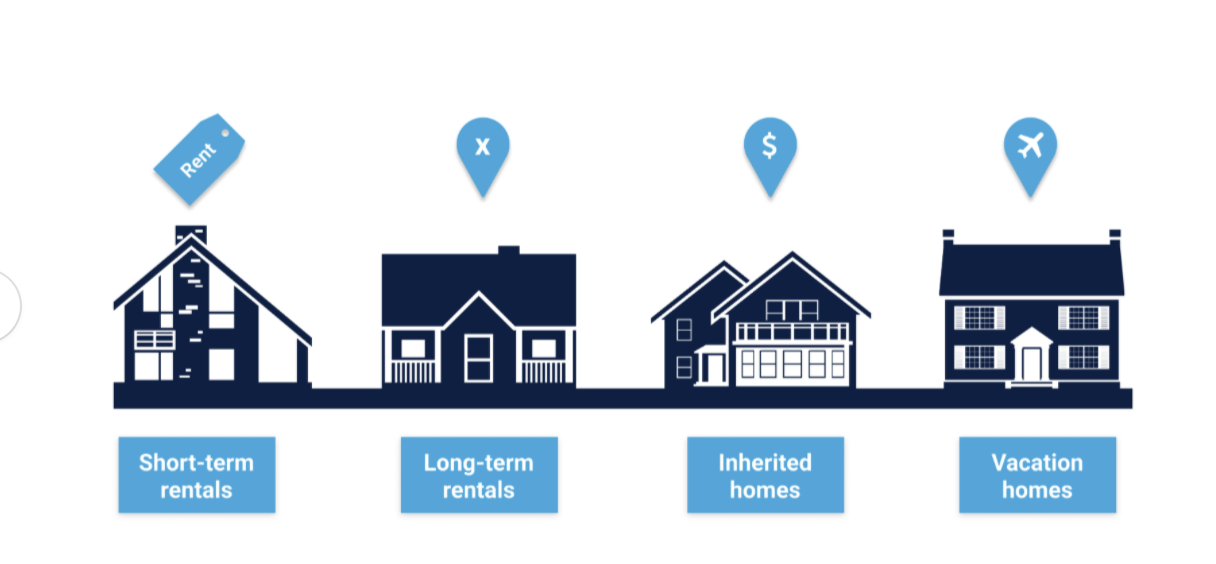
Short-term rentals
Opportunity
Marketing services, cleaning services, handypersons, and vacation rental companies all offer services that short-term rental owners may need. Realtors and investors may also find short-term rental owners are motivated sellers for the same reasons as long-term rental owners.
Additionally, home service companies and contractors can offer services that can help attract more customers, increase rents, and raise the value prior to a sale. Especially since many vacation rental properties are in urban or high-dollar markets selling experiences.
Pro Insights
Even before the COVID pandemic, vacation rental owners were overstretching budgets to get into these hot markets. Inexperienced investors are sometimes surprised to learn, after the fact, that local affordable housing issues drive local politicians to create rules banning or creating heavy restrictions and fees around short-term rentals.
As cities quickly banned short-term rentals with the onset of Covid-19 destroying the ability to make income, many investors discovered the investment was more of a speculation than an investment. Before diving into short-term vacation rentals, make sure to completely research local guidelines, permitting requirements, and even upcoming political agendas that could impact the business model. This could drastically change how you market to the owner and ultimately decide how to structure the deal.
Long-term rentals
Opportunity
Long-term rental owners might be ready to make a change with how they manage their property. A property management company could pick up a new client who’s tired of managing the three T’s (tenants, toilets and trash). If they are really tired of managing the property, Realtors and investors may find owners who are motivated sellers, willing to sell because they can cash out equity gains, are suffering from landlord fatigue, ready to exchange into other opportunities, or looking to consolidate their investment portfolios.
Even home services companies and contractors can offer services that help increase rents, raise value prior to sale, or remove management headaches.
Pro Insights
Pitching to these types of owners is different from communicating with owner-occupants.
Some landlords are extremely experienced and personally manage hundreds of properties. Approaching professional landlords with simplistic or unprofessional communications could destroy your chance at a big opportunity.
Do your homework and understand who you’re talking to before you connect. Unique opportunities and creating financing strategies like seller carry or subject to deals are more likely with sophisticated real estate investors.
Inherited homes
Opportunity
Inherited homes are an interesting segment of absentee ownership. When owners pass and don’t leave clear direction to who will inherit a property, it can sometimes take years to go through the legal process.
Along the way, problems can arise within families or somebody could inherit real estate and not know how to take the next step. Oftentimes, these absentee owners are not from the area, have little experience in real estate, and are in need of multiple services across the real estate and services industry.
Pro Insights
Some professionals specialize in inherited homes they understand and thrive in complex and unique scenarios.
Family infighting, probate issues, and title flaws are the norm when sorting through these deals. However, complexity doesn't always equate to competitions. If you are up for the challenge and you have the patience, going after inherited homes could help you secure more deals.
Vacation homes
Opportunity
Unlike short-term rentals, vacation homes are owner-occupied secondary homes. Areas with a majority of vacation homes can sometimes be the first to experience price damage during a recession as owners rethink their budgets and the costly maintenance, utilities, and holding costs associated with a second home. Especially if the property is rarely used. Real estate investors may strategically target these homes to hold as vacation rentals.
Local agents can target these owners for future listings knowing they reside out of state. Mortgage pros can reach out when interest rates decrease making ownership less expensive. Property managers may consider this a good audience for managing short-term or long-term rentals should the owner decide cashflow is the new goal.
Pro Insights
Pandemics, natural disasters and other unforeseen circumstances will create winners and losers in this category. For example, the COVID-19 Pandemic created a situation where an influx of professionals from urban markets started working remotely. More families also used this time to travel while kids were learning online. At the beginning of the pandemic, PropertyRadar’s CEO, Sean O’Toole, predicted that some vacation home markets could double in volume. Real estate professionals understood this nuance and monitored local markets for unique opportunities.
Strategies included master leasing vacation homes and turning them into vacation rentals targeting remote-working parents. Agents could help clients better position their listing for urban dwellers looking to relocate. And service providers can position themselves to help owners looking to reposition and upgrade to take advantage of those same opportunities.
How do you know which properties are which type?
There isn’t a specific set of criteria available in public records to let you know which type of property is which. Often you can use location and common sense to figure out which they are most likely to be.
- If the property is in an area that isn’t likely to appeal to visitors, it’s probably a long-term rental
- If the property is in a vacation destination, and the owner doesn’t own any other properties in the area, it’s probably a vacation home
- If the property is in a vacation destination and the owner owns multiple non-owner occupied properties nearby or in other vacation settings, then they are all likely to be short-term rentals
There will be exceptions to all of the above, of course, but even just by focusing on absentee owners, you will have already improved the targeting of your marketing tremendously.
Why Absentee Owners Make Perfect Prospects
An absentee owner can be a great potential client. A real estate investor can offer to buy the home of an absentee owner. A real estate agent can offer to list the home of an absentee owner. Meanwhile, a property manager can offer to manage the home of an absentee owner.
There are multiple opportunities to leverage absentee owners and generate more business. Below are a few examples of why an absentee owner might be motivated to sell:
- Landlord fatigue, especially if they have problem tenants
- Rents may provide a poor return on investment on the current property
- Frustration with law changes like new rent control rules
- Less emotionally attached—the property is an investment, and they may now see better opportunities
- Can no longer afford the vacation home
- Property is inherited and the heir doesn't know the market or plan to live in town
Not every absentee owner will be ready to sell or need your service. However, when we compare absentee owner properties to owner-occupied properties, it’s easy to see why so many opportunities abound.
Absentee owners aren’t selling their own homes, but rather an investment that they may be ready to divest.
How To Find Absentee Owners
Now that you understand the different types of absentee owners and which ones are a fit for your business, the question remains...how do you find them?
Here are some ways that you can go about it.
Looking for Absentee Owners? |
The county tax assessor’s office
To find this resource in your area, simply Google search the name of your county plus “tax records,” “tax assessor,” “check tax records,” or “search tax records.”
While counties often make property tax records available online, they typically only allow you to look up one property at a time. And even then, they often don’t show details like the owner’s name or mailing address. It is usually impossible to pull an absentee owner list directly from the tax assessors’ website.
Additionally, some counties charge a per record fee to pull the information. If you’re pulling one or two records, it’s no big deal. But if you’re a professional and you’re buying a list of hundreds and even thousands of records, you could very well end up paying hundreds and in some cases (depending on the county) you could end up paying tens of thousands of dollars.
Once you’ve paid, you’ll typically get your data from the assessor on CD-ROM. However, often there will be too many records to add to a spreadsheet like Excel, so you’ll need to load it into some sort of database. From there, you can comb through the records to see if the property address matches the owner’s mailing address. You’ll also want to check for homeowner tax exemptions.
Browse long-term rental listings
While not typically considered an absentee owner list, you can sometimes find absentee owners by browsing rental listings on Craigslist or other popular rental websites, or even your local paper.
Look for listings that appear to be posted by an individual landlord as opposed to a property management company. This works for contacting owners but rarely works to build a list of properties, as these listings usually don’t include the address.
Browse Airbnb and VRBO listings
Much as you would with long-term rental listings, you can find the owners of short-term rentals on websites like Airbnb and VRBO. And like with long-term rentals, you unfortunately often don’t get the address. If you are super motivated, you could drive a general area or potentially use Google maps and try to match the address to the picture.
While there are easier ways of finding absentee owners, you could, as just mentioned, drive a market to find potential opportunities. This is a common practice known as Driving for Dollars.
Driving For Dollars
If you choose to drive around an area looking for non-owner-occupied properties, there are some things you’ll want to keep your eye out for. Here are some things you’ll want to look out for depending on the type of property you’re interested in:
- Long-term rentals – Look for rent signs posted out front, with little to no outdoor décor with simple, basic landscaping with little to no property customizations or curb appeal.
- Short-term rentals – Look for the obvious signs of vacancy during the offseason in vacation settings. Digital door locks are another telling sign.
- Vacation homes – Look for signs of vacancy during the offseason in vacation settings, plus, look for more personalization and customization of the home and property.
Consider driving for dollars best practices to effectively connect with local residents. If you’d rather not spend your time driving around and taking notes of potential properties, you can save your time and spend some money by buying absentee owner lists
Cold calling
Cold calling gives investors the potential to get in touch with a prospect who might not know you or somebody who is not familiar with your business. The goal might be to find a prospect who is willing to engage and who would be interested in selling you their property.
Some landlords either grow tired of their tenants or might be open to the option of selling their property in general. While cold calling can often take time, it can be a valuable way to increase your marketing outreach and way to get in touch with absentee owners. Before you start cold calling to turn prospects into potential leads, consider looking into cold calling best practices. Preparing and doing your research ahead of time will help you turn any cold call into a warm conversation.
Buy a list of absentee owners
By far the easiest way to reach absentee owners is to purchase a pre-built list of absentee owners from a list broker, or real estate data provider. These do vary in quality quite a bit, with some vendors reselling lists that they only update once a year.
And while working off of an old list is challenging enough, basic absentee owner lists often get sold over and over again to tens, or even hundreds of other businesses like yourself. Which means you’re competing for the same stale leads with potentially hundreds of other businesses. Not an ideal situation if you’re a serious business owner who needs fresh, undiscovered leads to fill your pipeline.
That’s why you’re far better off working with a vendor where you can custom build multiple absentee owner lists with various types of targeting criteria like amount of equity in a home, length of ownership, home value, age of the owner, and other criteria you deem critical to defining your ideal customer.
And it’s smart to target owners and segment your lists, by those absentee owners whose mailing address is in another county, or another state, as they are certainly more likely to be motivated and need your help.
Even better, because you can segment your lists, you’ll have a deeper understanding of the owner’s needs, challenges, and potential life desires. That means you can better tailor your marketing messages to each list which puts you way ahead of the competition who are all reaching out with the same generic messaging.
Discovering and building multiple segmented lists of absentee owners (without paying for every list) is just one of the many reasons professionals use PropertyRadar.
Building A List Of Absentee Owners
So you might be asking yourself if you should buy a list or build one? What’s the difference? Buying a list versus building your lists can mean the difference between success and failure.
Should you buy an absentee owner list or build your own?
We’re firm believers in building your own custom lists and here’s why:
- When you buy a list, it becomes old and outdated the second you pay for it. Much like a new car loses value the second you drive it off the lot, a purchased list loses value the second you buy it. That’s because no one is adding to it, maintaining it, and continuously checking the property data and owner information for accuracy.
- When you buy a list, you can’t be certain that the data you’re paying for is clean and up to date. Was the data updated yesterday? Last month? Or 7-months ago? You simply have no way of knowing.
- The list that you’re buying has also been bought by countless others. It’s likely been used numerous times already because it’s the easy thing to do. That is to say, no one is thinking outside of the box and getting creative.
If you want to set yourself apart from your competition, buying the same list as everyone else isn’t going to make that happen. You have to build your personalized lists with custom criteria that you’re not going to get with purchased lists.
|
Dynamic lists vs. purchased lists
- Dynamic lists – These are prospecting and marketing lists that are continually updated as things change. For example, when a property meets the criteria you set because the owner moves and now makes them an absentee owner, that property & owner automatically get added to the list without you having to do anything. Consequently, when an absentee owner makes a property on your list their primary residence, they’ll no longer match your criteria and will automatically fall off your list. Contact information and property details also stay updated. These dynamic lists live inside of a property information platform like PropertyRadar.
- Purchased lists – These are lists that are one-time downloads of information. You can’t be sure how clean or up to date the data is and regardless of how fresh the data is, it starts becoming outdated the second you pay for it.
How to Build Your Own Dynamic List
Building a dynamic list of absentee owners within PropertyRadar is quite easy. In fact, you can start with ‘Quick Lists’, which are lists with predefined criteria based on the type of owner and/or property you’re targeting.
Let’s take a look at how this works within the PropertyRadar platform.
Here’s what you want to do:
- Select your desired area by Zip Code, County, City or by drawing a detailed shape around your desired market using the polygon tool.
- Select “Quick Lists > Investor > Absentee owner - out of area”
You’ll end up with a map highlighting your area and the number of properties that match your criteria. In the example below, 1,289 properties match the absentee owner criteria for the area we’re interested in:
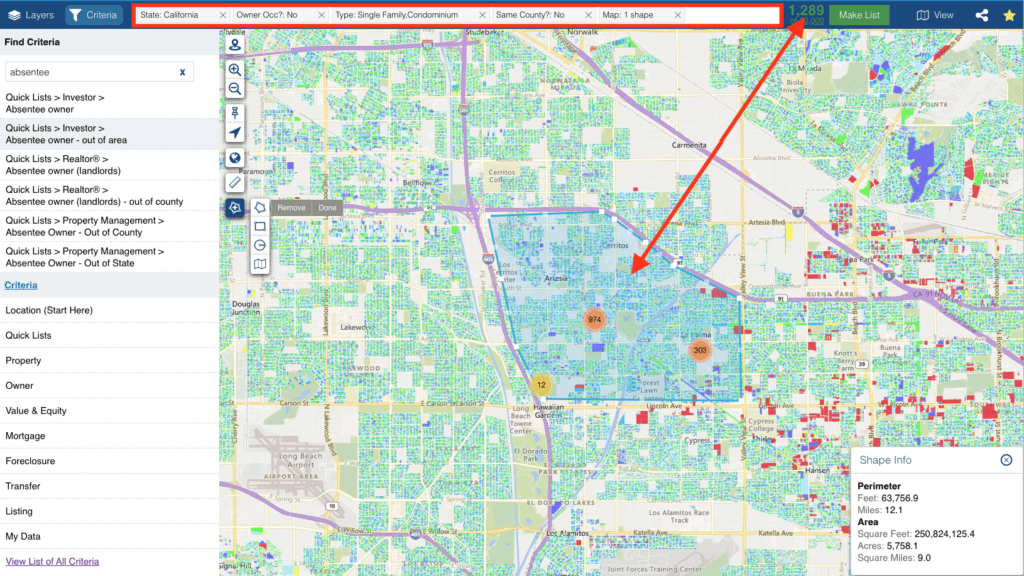
You can further segment your list out with additional criteria like equity, owner age, lot size, home size, and much more.
Let’s see how it looks after we add ‘Estimated Equity of 75%+’…
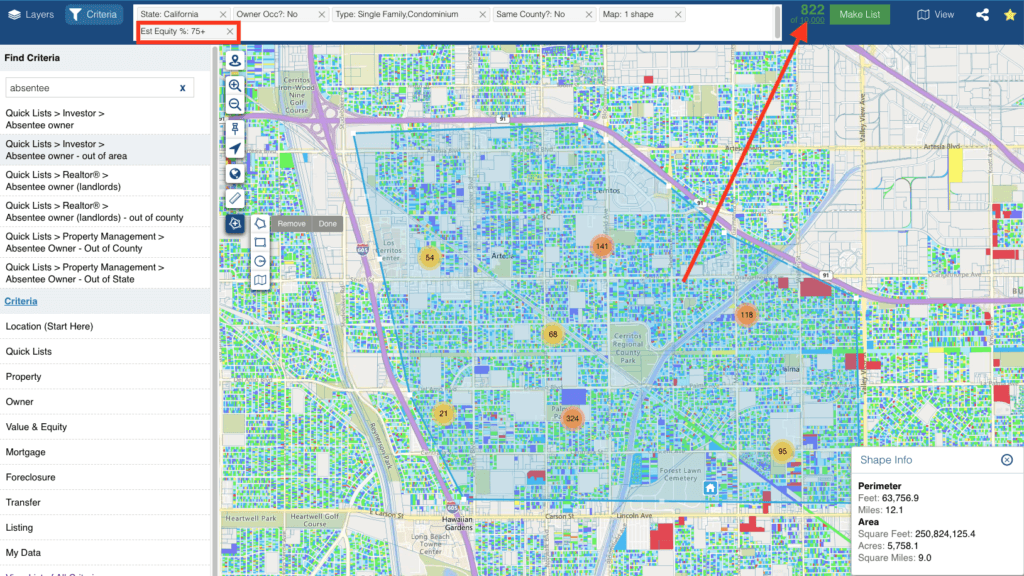
Now we’ve narrowed the list down from 1,289 to 822 properties. But let’s take a step further and instead of targeting out of county absentee owners, we target out of state absentee owners.
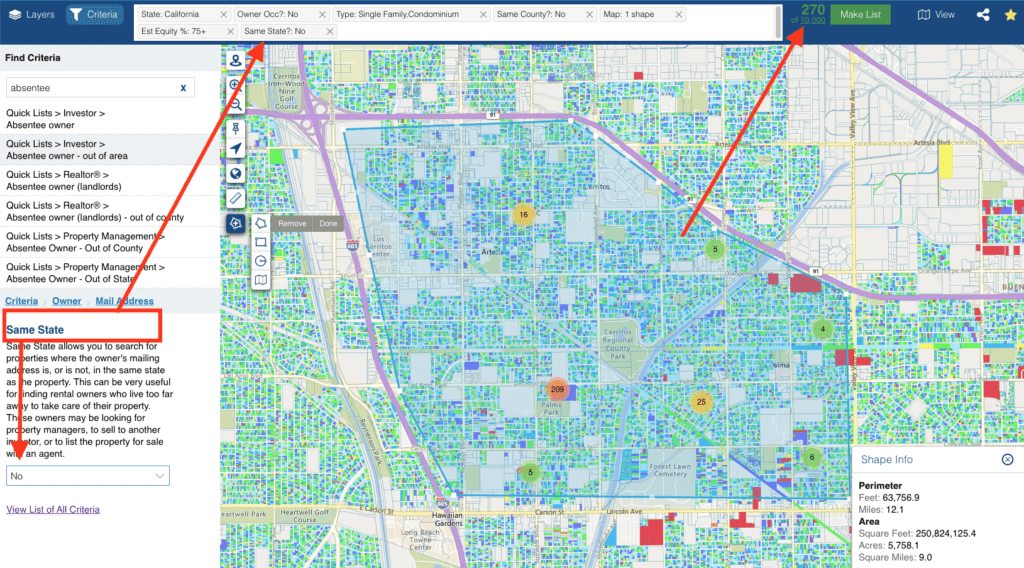
Now you have an incredibly targeted list of 270 properties owned by absentee owners who have at least 75% equity in the property and live out of state.
With such a highly targeted list, you can now tailor your marketing messaging to better resonate with your audience.
Can you see how customizing your own list with your specific criteria can be very powerful?
Once you’ve got your criteria set, click “Make a List” and give it a name.
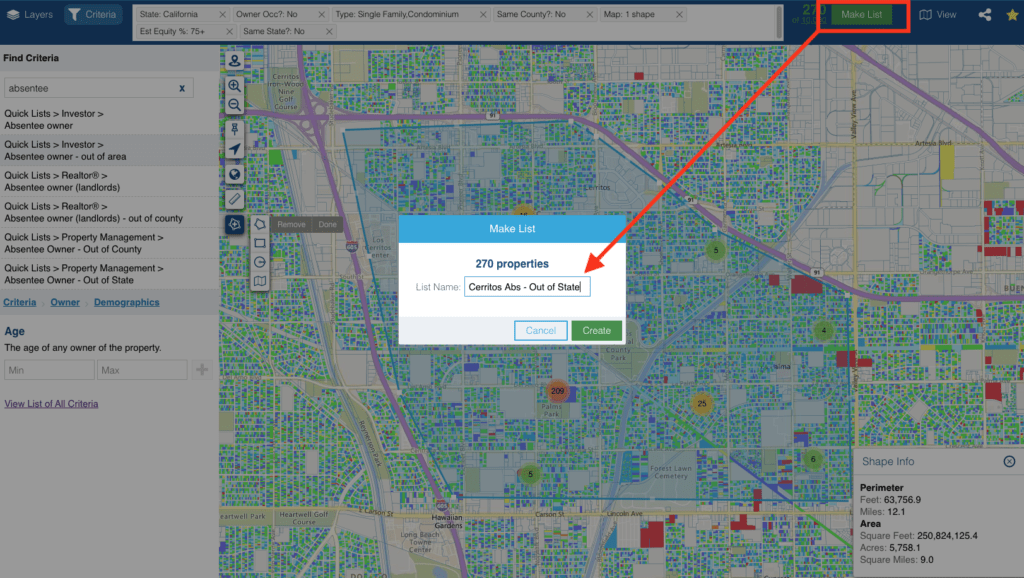
After you make your list, you can see all 270 properties that are inside of it.
And the best part is, this list will automatically update itself. So, when someone meets the criteria for your list, they will be added to it. When someone no longer meets the criteria, they will be removed.
Here are a few homes that show up on our list of 270 Cerritos absentee owners who live out of state. We’ve blurred out their names in this screenshot, but of course you can see them (and all of their contact info) when you login with your account.
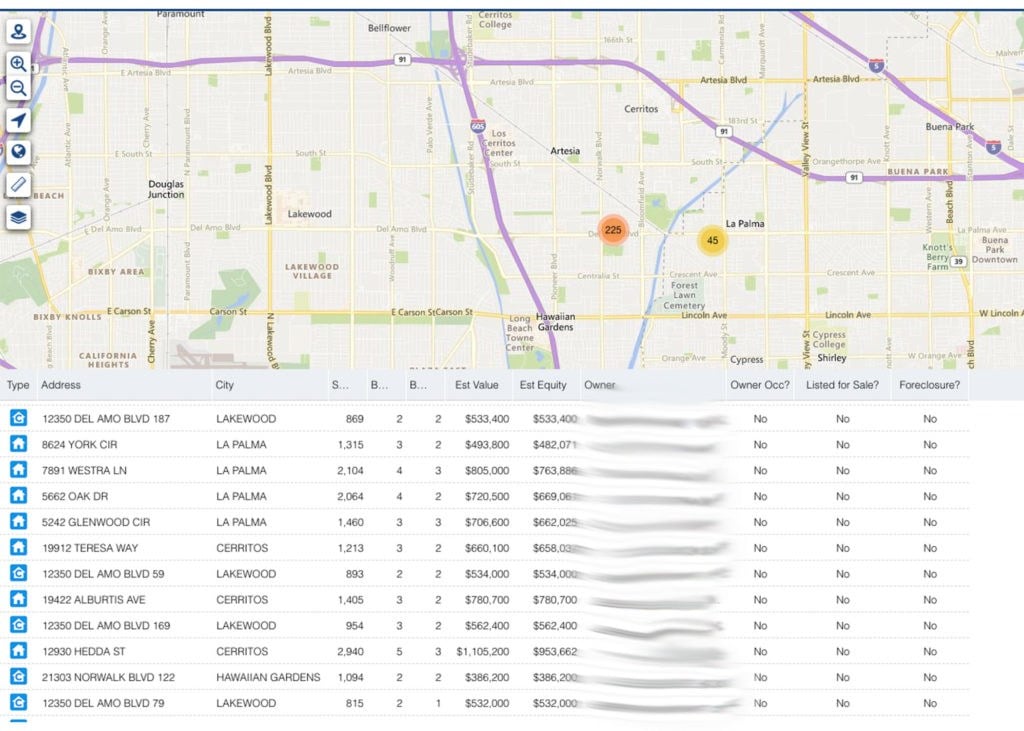
How To Customize Your Lists For Investors, Agents, and Property Managers
As we’ve just discussed, absentee owners come in all shapes and sizes. The criteria for which an investor may target an absentee owner may be different than that of a real estate agent or a property manager.
- For Investors: if you target absentee owners who paid all cash to purchase their properties in 2009-2011, they have seen lots of appreciation in the value of the home and now they may be tired and ready to cash out but they don’t want to deal with the headache of selling, evicting, etc. As an investor, you can come in and take care of all of that for them and buy the property at a discount.
- Realtors: Just like investors, Realtors can target absentee owners who might be ready to sell so they can list their home on the market. You could use the above example of non-owner-occupied properties bought in a certain date range.
- Property Managers: While realtors and landlords can have success with local absentee owners, as a property manager you’ll have the best chances of finding new property management leads when you find owners who aren’t local and need someone local to take care of the property. Ideally, the owner lives out of the county, or even better, out of state.
A challenge with buying lists is you’re often limited in the criteria you can use to create your lists. This means if you want to make various iterations of the same list with slightly different, but meaningful criteria, you have to purchase multiple lists. So, it should go without saying, that buying multiple lists can get extremely costly, and as previously mentioned, those lists start becoming outdated the second you buy them.
That’s a great advantage you get when using PropertyRadar. You can make as many iterations of the same absentee owner list as you like without paying for each list and each list is automatically updated for you so you never have to worry about your lists getting old on you.
Marketing: Turning Your Absentee Owner Lists Into Absentee Owner Leads
Now that you’ve built your various lists of absentee owners, the next step is actually reaching out to them.
Fortunately, with PropertyRadar, you have a number of options you can use to reach out to your audience. This includes direct mail, email, social media, online ads, and of course cold calling. So for any business that takes its marketing outreach seriously, you have the ability to create a great multi-touch marketing mix.
Let’s take a look at your options for contacting absentee owners in more detail.
Direct mail
PropertyRadar shows you the actual mailing address for absentee owners. Note how in this property profile the mailing address is different from the property address.
When you export your data or send it to your direct mail provider, just make sure to select the owner’s mailing address instead of the property address as the direct mail recipient.
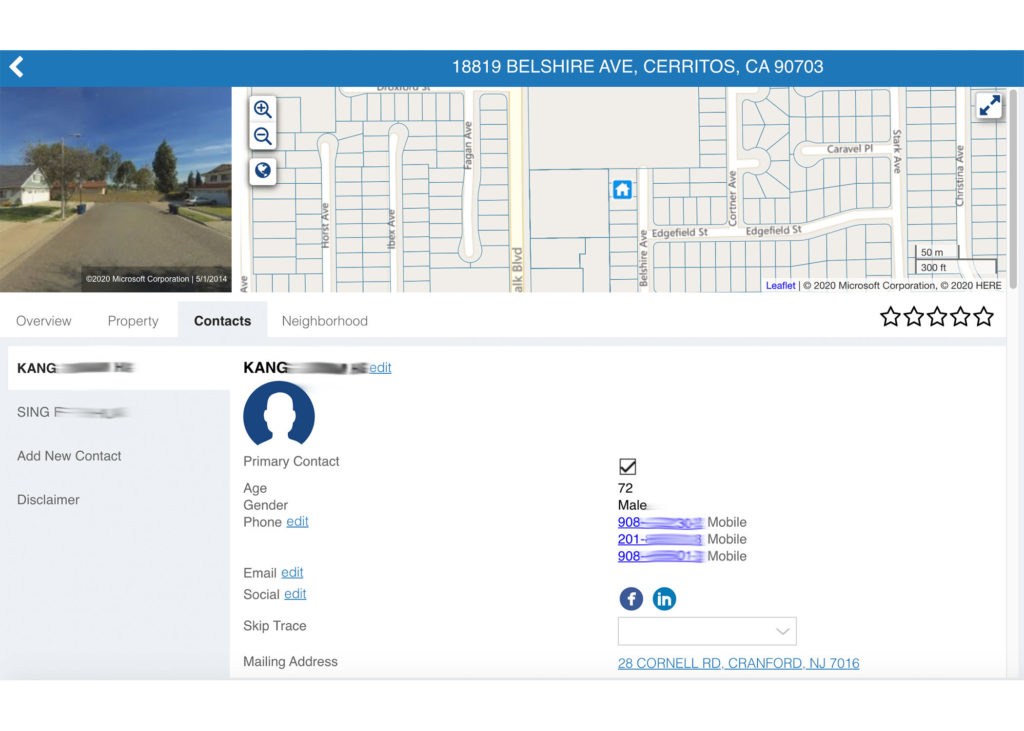
Cold calling
Another way that you can contact absentee owners is through cold calling. If you use a power dialer like Mojo to help you dial numbers faster (one-click) and track your efforts, then you can use PropertyRadar’s Zapier integration with Mojo to send the data over. Any power dialer that integrates with Zapier can be integrated with PropertyRadar.
Cold email
Same as with cold calling, you can hook up PropertyRadar to your cold emailing software using our Zapier integration. Then, when new homeowners get added to your lists, they’ll automatically receive cold email from you or you’ll get reminded to email them through your CRM (depending on how you set up your marketing software).
Direct social media messages
Another way to reach out to absentee owners is through direct messages on social media, particularly Facebook and LinkedIn. If you’ve had a hard time making contact over the phone, or you like to take a stand-out approach, then this can work very well. PropertyRadar makes it quick and easy to find social media profiles for most homeowners.
Online advertising using custom audiences and retargeting
And finally, you can use digital platforms and display ads to reach absentee owners in your area using custom audiences, lookalike audiences, and retargeting ads. If you’re a real estate professional actively looking to combine the best of inbound and outbound marketing, read up on the different tools and strategies available on Facebook, Instagram, Linked, and Google to drive even more impressions and conversions for your marketing dollars.
How to Beat Your Competitors
As you can see, finding absentee owners is only the beginning. What’s most important is being smart about how you contact them. Whenever possible, automate your marketing to save time so that your marketing campaigns are always on regardless of how busy you get.
Follow-up with prospects
Direct outreach is all about timing, and you’re not in control of reaching people at the perfect time. That’s why you have to reach out multiple times to increase your chances of connecting with them when they’re interested.
That’s why you want to set up multi-touch campaigns that reach people across a variety of channels. While the newbies spend their marketing dollars hitting 3000 different people at one time (and are never heard from again), we recommend you go the smart route and hit 600 targeted homeowners five times.
If you want your chances of succeeding to go up, you need to follow up.
Use automation to reach out before your competitors
Another super smart way to beat your competitors is to reach out to absentee owners before they do. This can happen in a couple of different ways:
- One - You set up alerts to get notified when someone gets added to your absentee owner list. When you get notified via email or mobile push notification, you can take immediate and decisive action. You can call, email, send a letter or postcard, or reach out however you feel is the best way to make an impact with your new lead.
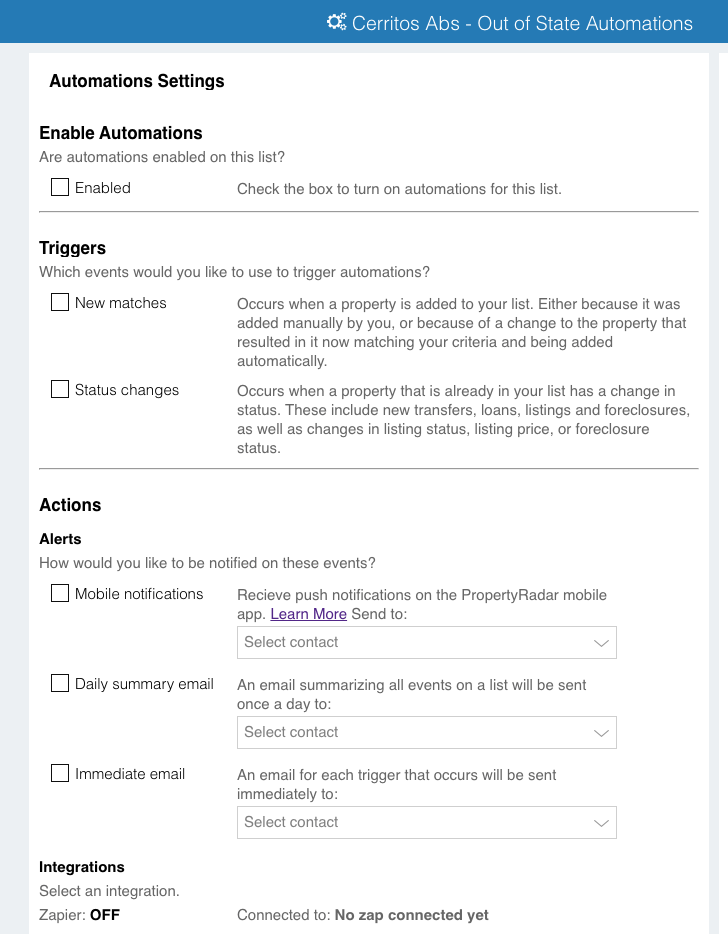
- Two – You set up marketing automation by integrating PropertyRadar to any of the more than 2,000+ apps and services. For example, integrating PropertyRadar with PRINTgenie lets you automatically send a postcard whenever a new lead hits your list.
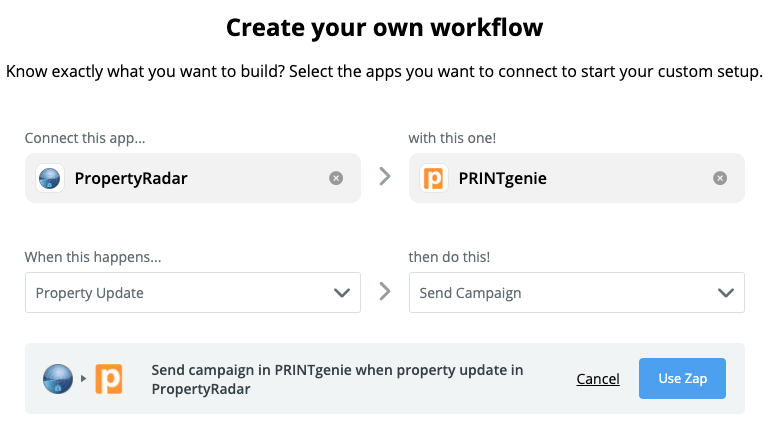
With this option, you never have to worry about your marketing outreach – it’s always ‘On’, even when you’re not.
Depending on the priority and importance of the marketing list, you can use both of these options separately or in conjunction.
Conclusion
Now that you know and understand the potential mindset of various absentee owners, it’s time to build and segment your absentee owner lists and start marketing to them. Remember a list is only as good as the data it's built with...and the freshness of that data. So, if you want to turn your lists into qualified leads and better still, closed deals, you need to…
- Build multiple, uniquely segmented absentee owner lists with various criteria.
- Create messaging that speaks uniquely to each of those segmented lists.
- Set up and start marketing using a marketing outreach mix of calling, emailing, online ads, and direct mail – and follow up!
Looking for Absentee Owners? |



